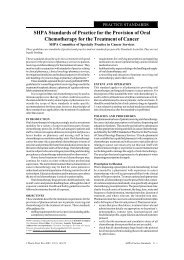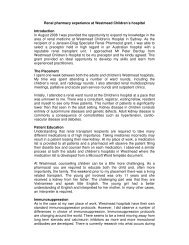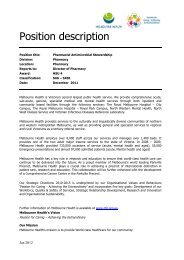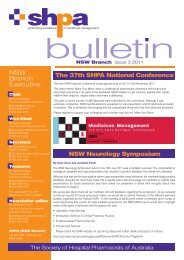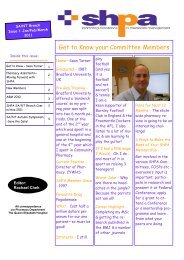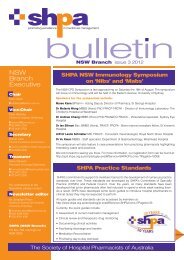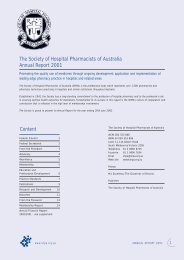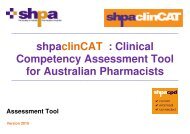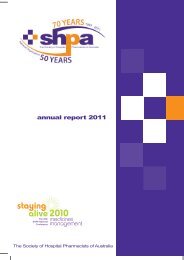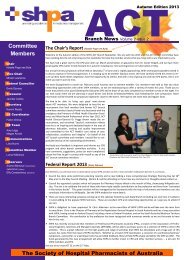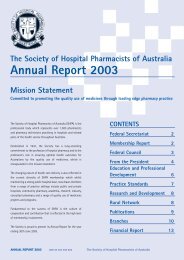references and background material - The Society of Hospital ...
references and background material - The Society of Hospital ...
references and background material - The Society of Hospital ...
Create successful ePaper yourself
Turn your PDF publications into a flip-book with our unique Google optimized e-Paper software.
KEY POINTS<br />
Medication reconciliation:<br />
1. is a requirement for meeting national Medication Safety St<strong>and</strong>ards. 1<br />
2. can significantly decrease medication errors <strong>and</strong> is recognised as a key strategy towards improving<br />
medication safety <strong>and</strong> reducing morbidity <strong>and</strong> mortality<br />
3. should be delivered to all patients but in particular those identified at risk <strong>of</strong> medication<br />
misadventure: in transition, or as a result <strong>of</strong> changes in their medical condition<br />
4. has been shown to promote safe <strong>and</strong> effective use <strong>of</strong> medicines.<br />
5. requires organisational, individual health service provider, <strong>and</strong> patient commitment,<br />
communication <strong>and</strong> teamwork<br />
Evidence shows pharmacists do medication reconciliation well.<br />
Some examples <strong>of</strong> research related to medication reconciliation<br />
Australian experience<br />
In 2002, patients seen by an ED pharmacist at a metropolitan teaching hospital ‘received a more appropriate initial medication<br />
regimen as reflected by a 75% reduction in the number <strong>of</strong> changes that the ward pharmacists had to make to the admission<br />
regimen’. Documentation <strong>of</strong> adverse drug reactions increased, pain management was provided earlier <strong>and</strong> concordance with<br />
antibiotic guidelines increased with involvement <strong>of</strong> an ED pharmacist. Satisfaction levels were high amongst ED staff <strong>and</strong><br />
patients. 27<br />
Pharmacist charting <strong>of</strong> medication histories was compared with eliciting histories in the ED after medications had been<br />
prescribed by doctors at a teaching hospital in Australia. <strong>The</strong> study found that accuracy increased when the pharmacist prepared<br />
the medication charts (for the doctor), reducing the frequency <strong>of</strong> an unintentional discrepancy. <strong>The</strong> study supports early<br />
involvement <strong>of</strong> pharmacists in compiling medication histories for medication chart preparation. 40<br />
An evaluation <strong>of</strong> a medication liaison service (MLS) was conducted in two major hospitals in Australia. <strong>The</strong> interventions involved<br />
a comprehensive medication history determined at admission confirming this with the admitting doctor <strong>and</strong> community<br />
healthcare pr<strong>of</strong>essionals. On discharge a comprehensive discharge communication was prepared with the hospital medical staff<br />
<strong>and</strong> forwarded to the patient’s GP <strong>and</strong> community pharmacy. <strong>The</strong> MLS resulted in improved patient outcomes, more<br />
interventions <strong>and</strong> medication changes to optimise therapy. <strong>The</strong>re was a significant decrease in community healthcare<br />
pr<strong>of</strong>essional visits <strong>and</strong> a tendency (not-significant) for reduced readmissions. 21<br />
A review <strong>of</strong> the literature highlighted strategies for improving medication reconciliation which include: use <strong>of</strong> a st<strong>and</strong>ardised<br />
medication reconciliation form, improved communication, a multidisciplinary approach, the use <strong>of</strong> computerised physician or<br />
prescriber order entry with decision support <strong>and</strong> home medication lists. 15<br />
A study to determine time required providing clinical pharmacy services to individual medical <strong>and</strong> surgical patients at two general<br />
hospitals, <strong>and</strong> the effect <strong>of</strong> complexity <strong>and</strong> presentation on this, found that the average time to undertake a medication history<br />
interview <strong>and</strong> medication reconciliation was 9.6 minutes (st<strong>and</strong>ard deviation 4.9). 28<br />
A continuous observational time-<strong>and</strong>-motion study to quantify time clinical pharmacists spend on various activities over their<br />
working day at a teaching hospital found pharmacist conducted medication history interviews took on average 11.3 minutes <strong>and</strong><br />
medication order review 2 to 3 minutes. 29<br />
A study at a metropolitan teaching hospital in Australia found the ED pharmacist providing timely medication histories was more<br />
likely to result in admitted patients receiving an accurate medication chart early in their hospital stay. Having a clinical pharmacist<br />
within the ED resulted in a greater than 70% relative reduction in errors. 41<br />
Overseas experience<br />
A study to identify discrepancies between medication histories taken by ED providers: physicians, nurses <strong>and</strong> medical students<br />
<strong>and</strong> clinical pharmacists in a tertiary care teaching facility found that the medication histories taken by clinical pharmacists were<br />
more complete than those by the other health pr<strong>of</strong>essionals. 22<br />
A 2010 systematic review examining the effects <strong>of</strong> US pharmacist – provided direct patient care noted that mortality,<br />
hospitalisation/ readmission, inpatient length <strong>of</strong> stay, <strong>and</strong> ED visits benefit greatly from pharmacist services as do safety outcomes<br />
which include adverse drug events <strong>and</strong> medication errors. 42<br />
SHPA Medicines in focus BACKGROUND MATERIAL – Medication reconciliation – November 2012 5 <strong>of</strong> 8




